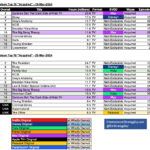When embarking on the journey of visualizing your family history, you might consider using genealogy software to create a Family History Chart. A common initial step is exporting a PDF from these applications or websites. However, you may quickly discover that this approach can be more cumbersome than efficient. Instead of streamlining the process, you might find yourself wrestling with formatting issues, spending valuable time adjusting box sizes and text objects.
The primary challenge with PDFs exported from genealogy tools lies in their structure. Often, these PDFs render each element—boxes and text—as separate objects. This means that resizing or modifying the chart becomes a laborious task of manipulating individual components. In contrast, creating a chart from scratch allows you to use text frames with strokes, simplifying scaling and adjustments as you are dealing with single, unified objects.
Choosing the best method hinges on the level of design control you desire and your comfort level with different software approaches. While exporting to PDF might seem like a quick solution, the subsequent formatting headaches can negate any initial time savings.
Drawing your family history chart from scratch offers maximum customization. However, this method isn’t without its potential pitfalls. Manually inputting all your genealogical information, even with copy-pasting, can be prone to errors. It’s easy to inadvertently misplace details when transferring data from one box to another.
Another avenue to explore for populating your chart is exporting data from your genealogy app or website into a text-based format. You can then leverage a powerful feature like Data Merge in publishing software to import this structured data directly into your family history chart template. While Data Merge demands a slightly steeper learning curve, it offers a more efficient and less error-prone way to integrate large datasets into your visual chart. Mastering Data Merge can be a worthwhile investment for more complex family history projects.
If you opt for the “from scratch” approach, a strategic starting point is to begin with a family member who has a complex life history – perhaps someone with a long name or multiple marriages. Designing a box that accommodates these details from the outset will serve as a robust template for the rest of your chart. For an enhanced visual appeal, consider incorporating thumbnail photos within each box, positioning the image to the left of the text.
Standard family history chart formats exist, but don’t feel constrained by them. Customization can significantly enhance the information density and readability of your chart. For instance, varying box heights based on the complexity of an individual’s life – such as the number of marriages – can visually encode additional information. Similarly, instead of cramming numerous individuals onto a single page, focusing on presenting richer details for fewer key ancestors can create a more engaging and informative chart.
One effective layout strategy is to designate a “key person” for each chart. Position this individual prominently, perhaps in a bolder box, with their parents above, their spouse beside, the spouse’s parents above the spouse, and their children below. Within each person’s box, include essential details such as their full name, age at death, birth date and place, marriage date and place (along with spouse’s name and birth/death years), and death date and place.
For example, a box might read:
Jane Middle Doe (age 78)
b. DATE: Town, State, Country
m. DATE: Town, State, Country to John Middle Smith (YEAR–YEAR)
m. DATE: Town, State, Country to William Middle Wilkinson (YEAR–YEAR)
d. DATE: Town, State, Country
While numerous conventional formats exist for family history charts, the key is to choose or create a format that effectively balances information density with visual clarity. The example format detailed above prioritizes packing substantial information into a compact space, which can be advantageous for detailed genealogical charts.
Ultimately, the best approach to creating your family history chart depends on your individual needs, technical skills, and desired level of customization. Whether you choose to meticulously draw from scratch, master the efficiency of data merge, or adapt elements from existing templates, the goal is to create a visually compelling and informative representation of your family’s rich history.

